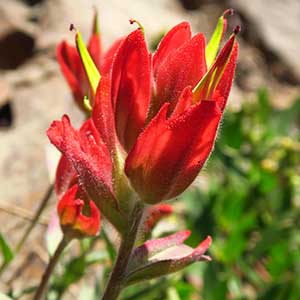Castilleja miniata
Castilleja elmeri
common paintbrush, common red paintbrush, giant red Indian paintbrush, great red paintbrush, scarlet Indian paintbrush, scarlet or common or giant red paintbrush, scarlet paintbrush
Elmer's Indian paintbrush, Elmer's paintbrush, Wenatchee Indian paintbrush, Wenatchee paintbrush
few to many, erect to ascending, rarely proximally decumbent or creeping and rooting at nodes, usually branched, glabrous, glabrate, or hairy, hairs spreading to ± retrorse, short to long, soft to stiff, rarely stipitate-glandular.
solitary or few to many, erect to ascending, sometimes slightly curved at base, unbranched, rarely branched, hairs moderately dense, spreading, medium length, soft, mixed with shorter eglandular and stipitate-glandular ones, at least on distal 1/2 of stem.
green to purple, linear to lanceolate, narrowly elliptic, narrowly oblong, or ovate, (1.5–)3–8(–9.5) cm, thin and not fleshy or slightly to moderately thickened and slightly fleshy, margins plane, rarely wavy, flat to involute, whole leaf sometimes recurved downward, 0(–5)-lobed, apex acute to obtuse, sometimes rounded;
lobes ascending-spreading, narrowly lanceolate, apex acute.
green, rarely purple-tinged, linear-lanceolate, sometimes linear or lanceolate, 1.3–6.5 cm, not fleshy, margins plane, flat or involute, entire, apex acute.
3–15(–22) × 1.5–5.5 cm, often bearing a thin, white, powdery exudate, especially on bract surfaces;
bracts greenish, scarlet, red, red-orange, or pale orange throughout, sometimes pink, magenta, pink-purple, yellow, greenish yellow, white, or salmon throughout, or proximally greenish, distally colored as above, lanceolate to oblong-ovate, 0–5(–7)-lobed, central lobes sometimes distally apiculate;
lobes erect, linear to lanceolate, oblong, or oblanceolate, short or medium length, arising near or above mid length, central lobe apex obtuse, rounded, or truncate, lateral ones rounded to acute or acuminate.
2.5–9 × 1.5–3 cm;
bracts red, crimson, scarlet, pink, magenta, red-orange, burnt orange, orange, pale yellow, or whitish throughout, or proximally greenish, distally as stated above, oblong, narrowly obovate, elliptic-oblong, or narrowly ovate, 0(–5)-lobed, rarely with 1 or 2 pairs of short, usually distal lobes;
lobes ascending, lanceolate, very short, arising from distal edge, apex rounded to obtuse.
0–5 mm.
0 mm.
slightly curved, 20–48 mm;
tube 12–26 mm;
abaxial lip usually not exserted, though often visible in front calyx cleft, beak partially to fully exserted;
beak adaxially green to yellow-green or whitish, (9–)14–25 mm;
abaxial lip incurved or ascending, deep green or green, sometimes deep purple or yellowish, reduced, not inflated, visible in front cleft, 0.5–3.5 mm, 5–20% as long as beak (to ca. 33% as long as beak in some populations of var. miniata);
teeth incurved or erect, green or white, 0.7–1.5 mm.
straight, 20–33 mm;
tubes 13–18 mm;
beak, and sometimes abaxial lip, partially to fully exserted;
beak adaxially green to yellowish, 8–15 mm;
abaxial lip incurved, green, thickened, 2–3 mm, 20–33% as long as beak;
teeth ascending or incurved, green, 0.5–1 mm.
colored as bracts, 15–38 mm;
abaxial and adaxial clefts 4–24 mm, 35–70% of calyx length, deeper than laterals, lateral (1–)3–8(–12) mm, 5–30% of calyx length;
lobes linear or narrowly lanceolate to narrowly triangular, apex acute to acuminate or obtuse.
proximally green to pale green, distally colored as bracts, 15–25 mm;
abaxial and adaxial clefts 5–14 mm, 33–50% of calyx length, deeper than laterals, lateral 1–4 mm, 6–20% of calyx length;
lobes lanceolate to narrowly triangular, apex rounded to obtuse.
= 24, 48, 72, 96, 120, 144.
= 48.
Castilleja miniata
Castilleja elmeri
Varieties 4 (4 in the flora).
Castilleja miniata is widely recognized as the common scarlet paintbrush. It is highly variable and has five levels of polyploidy. Nonetheless, it remains fairly well defined morphologically across its wide range. Native Americans use it medicinally. A probable hybrid with C. septentrionalis from southern Nevada was named C. ×porterae Cockerell.
(Discussion copyrighted by Flora of North America; reprinted with permission.)
The bracts and inflorescences of Castilleja elmeri can be red, crimson, scarlet, pink, magenta, red-orange, burnt orange, orange, pale yellow, or whitish. While the coloration is highly variable between local populations, it is usually uniform and consistent within them. It is found primarily in the Wenatchee Mountains of Washington, where it is often on serpentine, but it ranges northward in the Cascades into extreme southern British Columbia, apparently on non-serpentine substrates. Hybrids with C. miniata var. miniata, C. parviflora var. albida, and C. thompsonii have been found in the eastern Cascades of Washington, and a similar hybrid swarm with C. thompsonii is reported from southern British Columbia.
(Discussion copyrighted by Flora of North America; reprinted with permission.)
1. Bracts distally pale yellowish, pale orange, or salmon, sometimes pale red; n, c British Columbia, adjacent wc Alberta, s Yukon. | var. fulva |
1. Bracts distally scarlet, red, or orange-red, sometimes orange, pink, pink-purple, magenta, pale orange, yellow, greenish yellow, or white; widespread in much of w North America south of the arctic. | → 2 |
2. Stems glabrous or glabrate proximally, hairy medially and distally; leaves appressed-ascending, ascending, or spreading, often thickened and slightly fleshy; calyx lobe apices acuminate; Cuyamaca, Laguna, San Bernardino and e San Gabriel mountains of sw California. | var. oblongifolia |
2. Stems glabrous or sparsely hairy proximally and medially, subglabrous or sparsely hairy distally; leaves spreading to ascending, thin and not fleshy (except sometimes in var. dixonii); calyx lobe apices acute to acuminate or obtuse; widespread in w North America. | → 3 |
3. Leaves linear to lanceolate, narrowly elliptic, or narrowly oblong, apices acute to acuminate, sometimes obtuse; calyx lobe apices acute, sometimes acuminate or obtuse; widespread in w North America, except near coast. | var. miniata |
3. Leaves narrowly lanceolate to ovate, narrowly elliptic, or narrowly oblong, apices rounded to obtuse, sometimes acute to acuminate; calyx lobe apices acute to obtuse; coastal, from extreme nw Oregon northward to British Columbia. | var. dixonii |
- Local floras:
BC,
CA,
OR,
WA
- Local Web sites:
CalFlora,
CalPhotos,
Flora NW,
PNW Herbaria,
Turner Photog.
WildflowerSearch
iNaturalist (observations)
USDA Plants Database
- LBJ Wildflower Center
- SEINet
- Plants of the World Online
- Encyclopedia of Life
- Wikipedia
- Google Image Search


